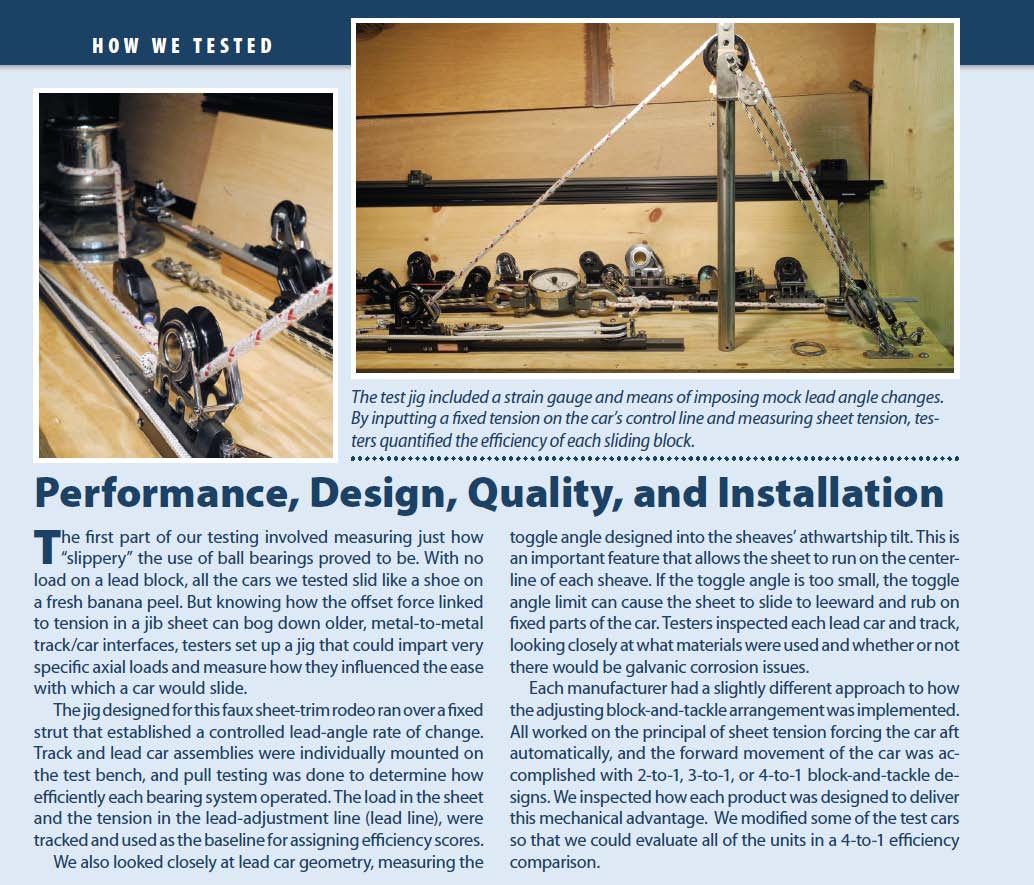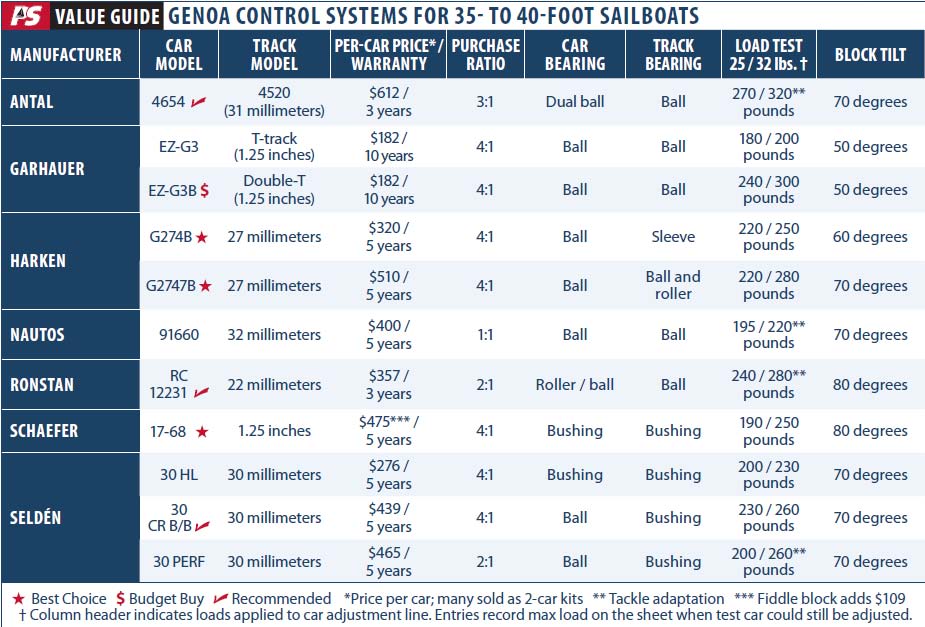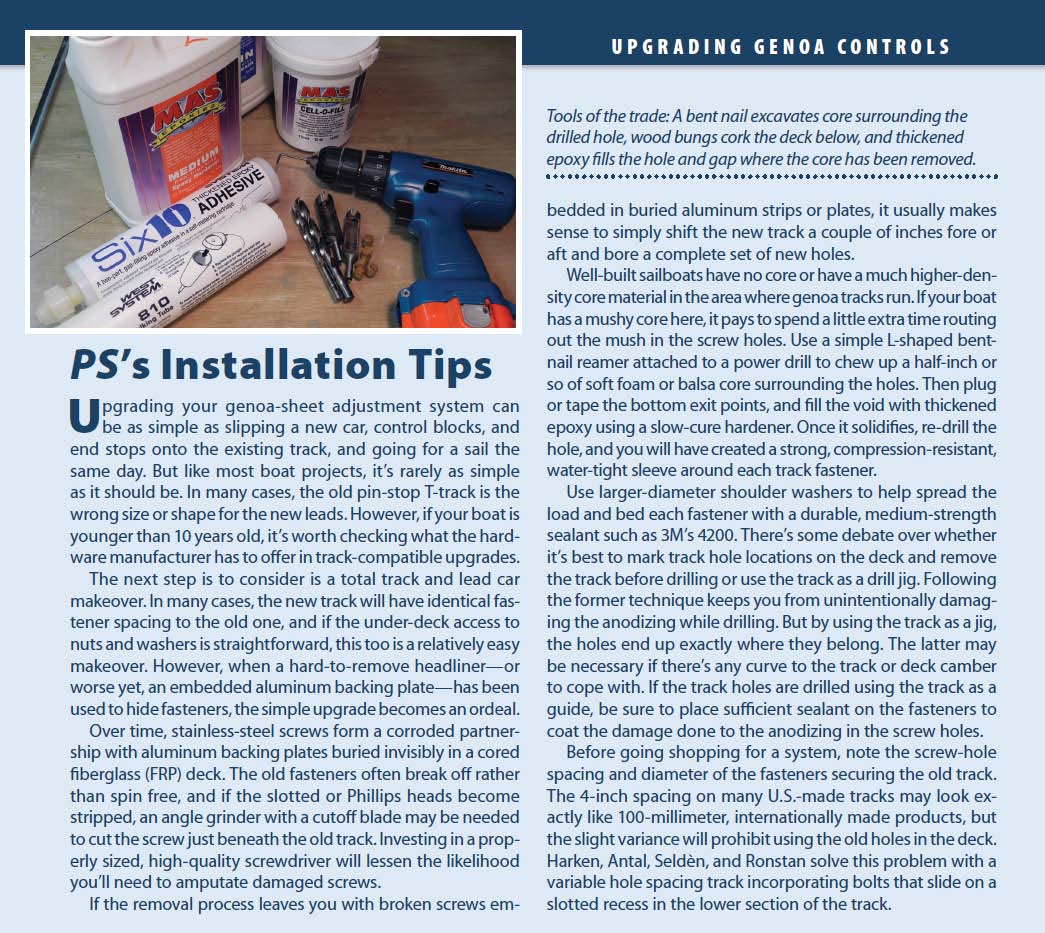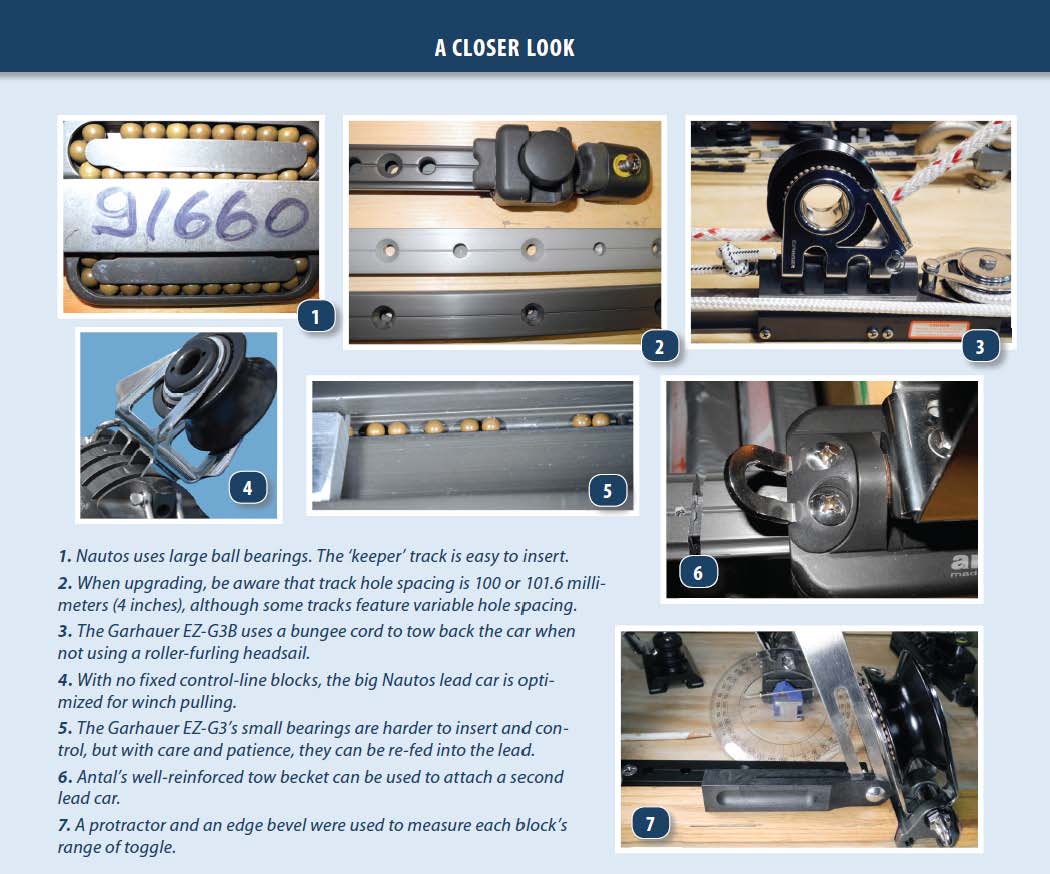For decades, easily adjusting genoa-sheet leads from the cockpit was a luxury ascribed to the racing sailboat. But todays average daysailer or cruiser equipped with a roller-furling headsail also benefits from a handy, efficient, and safe means of adjusting the genoa sheets lead and optimizing sail performance.
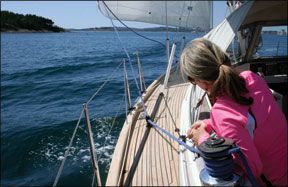
The clew of a reefable headsail moves during the reefing process, and so should the sheet lead position. If the lead is left in the same place when the headsail is reefed, either the sails foot or leech will be over tensioned, while the other edge ends up under tensioned. Proper sail trim has as much to do with the sheet lead angle as it does with how much the sheet is trimmed or eased. By eliminating leech sag or over tension, a crew derives better sail shape and an attendant uptick in performance. The headsail also will maintain its sewn-in shape longer, and with less leech flutter and foot stretch, its lifespan also will be extended.
A lot has changed since our last in-depth look at genoa lead cars (PS, November 1996), so with a dual focus on racing and cruising boats, we rounded up genoa-sheet lead controls for sailboats in the 35- to 40-foot range. Our goal was to measure the genoa-sheet controls operational efficiency, design attributes, construction quality, and ease of installation; price and warranty were also considered. For details on the test protocol, check out the accompanying How We Tested.
What We Tested
We tested 11 genoa-sheet lead cars and tracks from the industrys top manufacturers of sailboat deck hardware: Antal, Garhauer, Harken, Nautos, Ronstan, Schaefer, and Seldn.
Photos by Ralph Naranjo
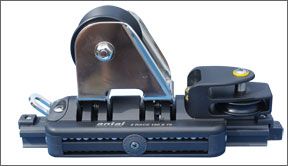
From Antal, we tested the 150-size genoa lead (model 4654), which sports a 60-millimeter sheave and is recommended for sailboats up to 42 feet, along with the model 4520 anodized-aluminum track. Garhauer submitted two of its lead cars (EZ-G3 and EZ-G3B), as did Harken, which sent the G274B and G2747B for review. Seldn delivered three different lead cars (30 HL, 30 CRB/B, and 30 PERF) that all run on the companys 30-millimeter, extruded anodized-aluminum track.
The heavy-duty Nautos 91660 genoa car was the big dog of the pack, weighing nearly 2 pounds with a 120-millimeter lead and a 75-millimeter sheave that spins on roller- and ball-bearing races. We also evaluated Ronstans Series 22 lead car (RC-12231) and track, and Schaefers simple, elegant 17-68 car and 1.25-inch T-track.
One of the first trends we noted among the test products was a move toward more friction-free ball bearings and less use of high-molecular-weight plastic bushings. Both options lessen friction and improve the way a lead car slides down the track. Under no load, the ball bearing-equipped cars got the greased lightning award, but they are more expensive. And when the load is on, ball-bearing lead cars move with less friction. In all instances except with the Harken cars we tested, care must be taken to keep the ball bearings from escaping. The trick is to keep the stub track in the lead and use it to thread the car onto the track. If you slip, the car will shed plastic ball bearings like a broken bag of marbles, heading straight for deck drains and other irretrievable hiding places. Another trick, which Seldn suggested, is using gel shaving cream to hold the last few bearings in place while you attach the end fittings.
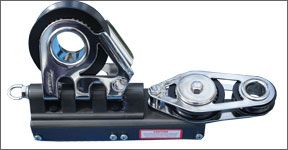
A few test units provided bungee-cord assisted retraction to hold unloaded cars in place. Others assumed that the sheets led to roller-furled headsails would keep the cars tensioned.
Antal
Antals genoa-lead car (model 4654) slides on a dual-race, ball-bearing surface with one Torlon and one Delrin circuit per side. The car handles vertical, side, and torque loads evenly, and even if the bearings are destroyed, the car remains captive on the track. The reinforced resin sheaves run on an axle with twin ball-bearing races on either side of the sheave. The extruded, anodized aluminum, hollow-section track can be matched with various multi-purchase sheaves that allow for adjustable car control. The box-section track is light and stiff.
The car is a carefully designed and exactingly built piece of deck hardware. The manufacturer has gone to significant effort to galvanically isolate dissimilar metals. The dual-race bearing system supporting the lead car delivers a friction-free spin. The Antal offered the best power in/power out ratio among the lead cars we tested.
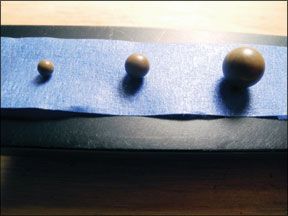
For part of our testing, we added an extra block to make the car control line deliver the same 4-to-1 mechanical advantage that most of the other test products had built in. Antal does have a double-sheave end fitting with a becket, but the test unit had only a 3-to-1 purchase. The 4-to-1 ratio was consistent with the test protocol, and the Antal 150 presented the least resistance under the highest loads.
The only downside we could find with the Antal system was the lead cars $612 price tag. Its three-year warranty tied with the Ronstan car for the shortest in the test field.
Bottom line: This car and track may be overkill for the average cruiser-racer in this size range, but boats with large furling genoas and crews spending lots of time racing or cruising offshore will appreciate the optimized adjustment capability, reliable operation, and long-term durability that Antal offers. We Recommend it.
Garhauer
The Garhauer EZ-G3 and EZ-G3B both use the same smooth-running, ball-bearing blocks with large-diameter bearings, but the EZ-G3 car has very small Torlon ball bearings and runs on a low-profile T-track. The EZ-G3B rides on medium ball bearings and slides on a stiffer, heavier-duty anodized-aluminum track with a larger cross-section. The latter delivered a 50-percent increase in pull power over the former when 32 pounds of tension was placed on the control line, and its improved effect on sail trim would be noticeable underway. Both Garhauer cars offer a 4-to-1 tackle arrangement for car control, and the sheaves spin like roulette wheels with extra ball bearings.
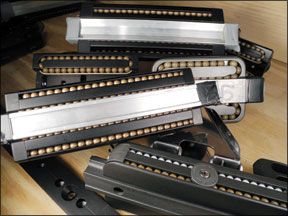
Garhauers powerful pull goes hand-in-hand with the larger size of its blocks. Testers did note that the smaller-diameter ball bearings used in the EZ-G3, and to a lesser extent the EZ-G3B, are best kept in the lead car. When they escape, they are harder to find than the larger-diameter ball bearings used by competitors.
Priced at $363 for the total package (two EZ-G3 cars and two track lengths), or $182 per car, Garhauer once again finds a balance between performance and aggressive pricing. However, the EZ-G3B and its track are heavier than all other competitors (12 pounds per side); this may be an issue for racers prone to cutting the handles off their toothbrushes.
Bottom line: Cruisers, and racers who are less boat-weight-conscious, will find that the Garhauer systems offer a lot of value, not to mention the raw power in the EZ-G3B, which gets the Budget Buy pick. Testers were not as enthusiastic about the EZ-G3s small ball-bearing lead car alternative. Despite its being equipped with a smooth-running sheave, the block bogged down under load, and its performance fell well behind the EZ-G3B.
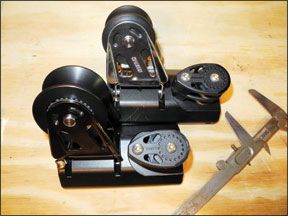
Harken
Harkens 27-millimeter G274B and G2747B cars had cleverly engineered, lock-in-place, Torlon recirculating ball bearings. The lock-in-place bearings stole the show when it came to slipping ball-bearing lead cars on and off the track.
The G274B incorporates a pressed stainless-steel sheave cage, a nylon-resin GRP sheave, and a bushing-type bearing. The G2747B is identical to the former, except the stainless block cage has a black abrasion-resistant coating and a tang for bungee attachment. It also has a very smooth spinning, larger-diameter sheave that uses ball and roller bearings to reduce friction during trimming. Both systems toggle 60 degrees to accommodate lead-angle offsets, and both sheave cages are wide enough to handle two sheets.
Racers counting weight as well as efficiency should take a close look at the Harken blocks. After repeated testing, it was clear that the most important uptick in efficiency comes from making the track-to-car interface a smooth ride, and thats just what Harken offers in both of these lead cars, with the G2747B having a little extra slipperiness.
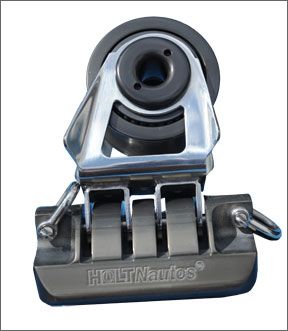
Bottom line: The Harken cars are light and compact, but offer lots of power and easy handling. They are the Best Choice for light-displacement boats.
Nautos
Among the leads we looked at, the carefully engineered, high load-bearing Holt Nautos 91660 genoa car was in the big-dog pack, along with the Antal, Garhauer, and Schaefer. The wide sheave easily accommodates two sheets, and the sheave cage was well attached to the car via a four-point toggling hinge. There are shackles at each end of the car, but no built-in control blocks, making the car best suited for a winch-tensioned control line. It can be used with other brands of track as well.
Because our testing used a 4-to-1 tackle, we set up such a system to deliver the pull force. The Nautos car delivered results toward the lower end of our test range, but when loaded to 500 pounds, it was still an easy car to slide.
Bottom line: Testers liked the Nautos systems structure and quality of manufacture, but in this tight field of quality products, it was out-performed by other products overall.
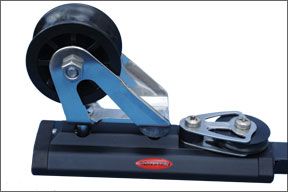
Ronstan
Ronstans Series 22 lead car (RC12231) runs on Torlon ball bearings, and like most of the other ball-bearing-equipped cars, it comes with a short section of track that keeps the slippery bearings captive. By carefully butting the short keeper track section with the end of the deck-mounted track, the car can be positioned on the boats track much like a railroad car emerging from a sidetrack. The stainless-steel sheave cage mounts to the car via two welded forks, toggling on a smaller-diameter pin. A rubber grommet keeps the clatter down as the lead car toggles.
There was a lot to like in the Ronstan genoa car, and it performed quite well in testing-holding its own with the big dogs. It slid quietly and efficiently on the small, lightweight 22-millimeter track, sounding like a gear train shifting smoothly, rather than a bag full of silverware being dragged along the deck. The grommet placed on the toggle leg tamed the slat-slat sound caused by a flailing sheave, and the lead had enough side-to-side play to cope with a wide range of car-to-clew geometry. We did have to lash on a block to arrive at 4-to-1 parity with others tested, but there is a 3-to-1 setup that would work just fine.
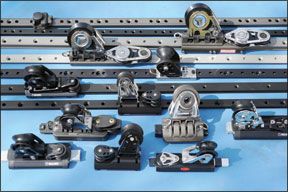
Bottom line: Ronstans lead car gave Harken a run for its money, but it was nosed out by the latters captured ball-bearing race and five-year warranty. Nevertheless, this is a compact and capable system that will perform well, and we can Recommend it.
Schaefer
Schaefer displays both simplicity and elegance in its stainless-steel 17-68 car and wide, nicely machined anodized-aluminum sheave cage. The bushing-and-axle supported sheave offers a wide lead that will easily accommodate two sheets during sail changes.
The spring-dampened toggle is a nice touch that will diminish clatter in rolling conditions offshore. A high molecular-weight plastic track bushing is an alternative to ball and roller bearings. As might be expected in a bushing-type car, the efficiency was not up there with the plastic ball-bearing gear we tested, but it is more likely to take the ravages of time and environmental harassment in stride. And its slight increase in friction may be a fair trade for the simplicity and reliability.
Testers especially liked the Schaefer units nut-and-bolt sheave axle and the fact the user can easily remove and replace key parts, even the bushing surface. They were further impressed by the high-quality stainless-steel work and the efficient fiddle-block tensioning control system.

0)]
Bottom line: The overall quality of the Schaefer gear and its user-friendly maintenance abilities make it a good choice for those headed over the horizon. Its the Best Choice for bluewater voyagers and cruisers in far-flung locales.
Seldn
The three different leads Seldn sent us to review define the companys approach to genoa-car design. The compact, high-load 30HL plastic-bushing car came with an inclined base and an up-angle lead that puts less load-handling stress on key parts of the cast, double-sheave cage and car. The casting includes built-in sideplates for control-line sheaves. Testers found that the configuration made rigging control lines a bit of a nuisance, but because this is only done to set the system up, we did not consider it a major issue. The price, reasonable efficiency, and compact design all made this car a solid competitor.
The 30CR B/B is a Torlon ball-bearing car with the same sheave and cage as the 30HL. Testers liked that its built-in blocks delivered a 4-to-1 pull. The bushing-supported sheave and ball-bearing car were the right combination, delivering a smooth-riding, compact lead. A rubber mini-fender stopped the clatter linked to a flailing sheet, and the load on the control line increased evenly all the way through the range.

1)]
Seldns performance car, the 30 Perf, is nicely designed and engineered. It incorporates a longer ball-bearing car and a stainless-steel sheave cage and toggle that also compensated for lead-angle changes 90 degrees off the toggle axis. Opposite the car control block was a becket to attach a bungee cord or a second lead on the same track. It was the only lead we tested that offered a two-plane toggling ability to better align the sheave. The long ball-bearing car had to have a second block added to achieve a 4-to-1 ratio, but it did not run as smoothly on the track as the 30CR B/B.
Bottom line: There were features found in each of these blocks that testers looked on favorably. The 30CR B/B incorporated a ball-bearing track-to-car interface, slid smoothly, and earned high marks for design attributes. Despite its $439 price tag, the 30CR B/B is a PS Recommended piece of hardware.
Conclusion
Both racers and cruisers benefit from underway sheet-lead adjustability, and our test results showed that no one product answers all needs. For the more competitive boat owners aboard lighter-displacement boats, the Harken and Ronstan systems were neck-and-neck. Testers liked the smooth slide of each of these cars. Ronstan uses a thick rubber grommet to tame the slat-slat clatter of a flailing sheet, but Harken leaves users with the sound of speed. In the end, it was Harkens trapped ball-bearings, full complement of track ends, and other features that sealed the deal. The Harken G274B and G2747B get the Best Choice for lightweight performance boats, and Ronstan earns our Recommendation.

2)]
Those with higher-displacement boats should consider the Antal and Schaefer. The former delivers the apex of efficiency, and the latter is well-made gear thats easy to inspect and can be repaired with a minimum of specialized parts. For those headed offshore, the Schaefer is the Best Choice. Seldns 30CR B/B was a solid performer and for those not tethered to a tight budget, it too is Recommended.
Garhauers EZ-G3Bs ring pins are snag prone and its toggling range is limited, but it is a lot of hardware, performed well, and boasts a lot of efficiency for $182 per car. It gets the Budget Buy pick.
Whichever unit you select, check out the options list for things that will make installation easier. For example, buy extra ball bearings if your system uses them and make sure that secure end stops prevent an inadvertent fly-off-the-track disaster.
